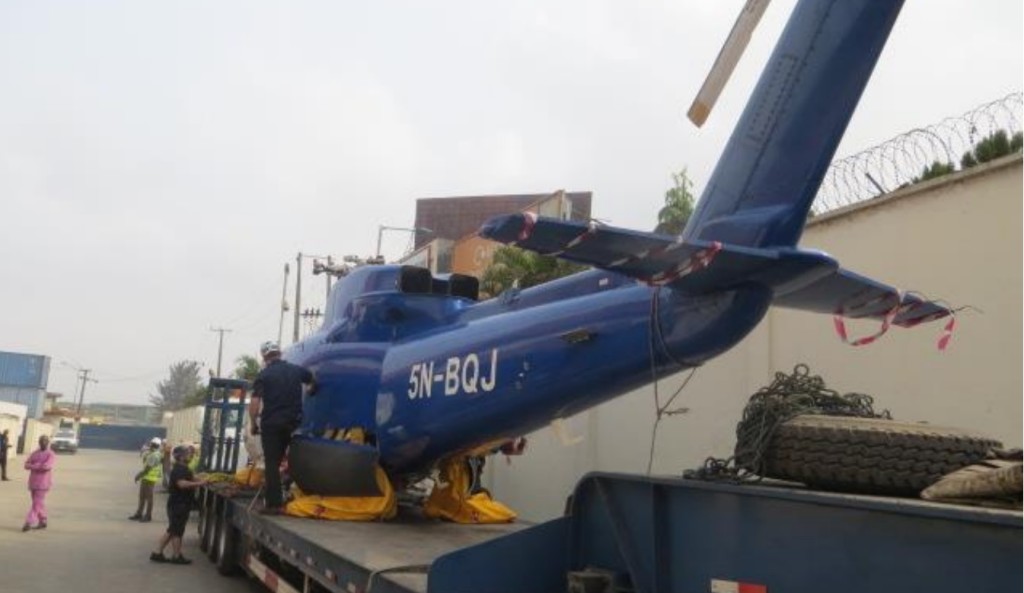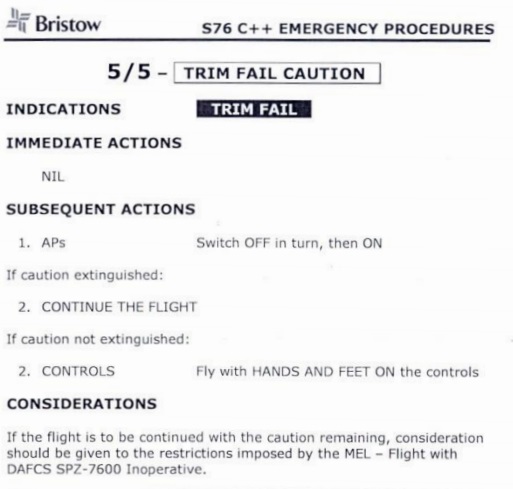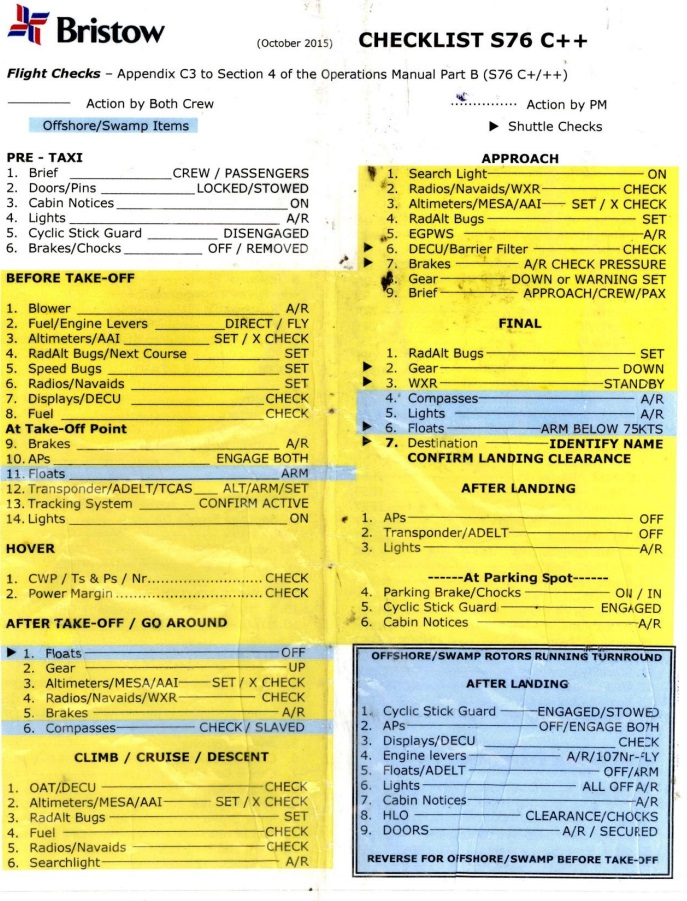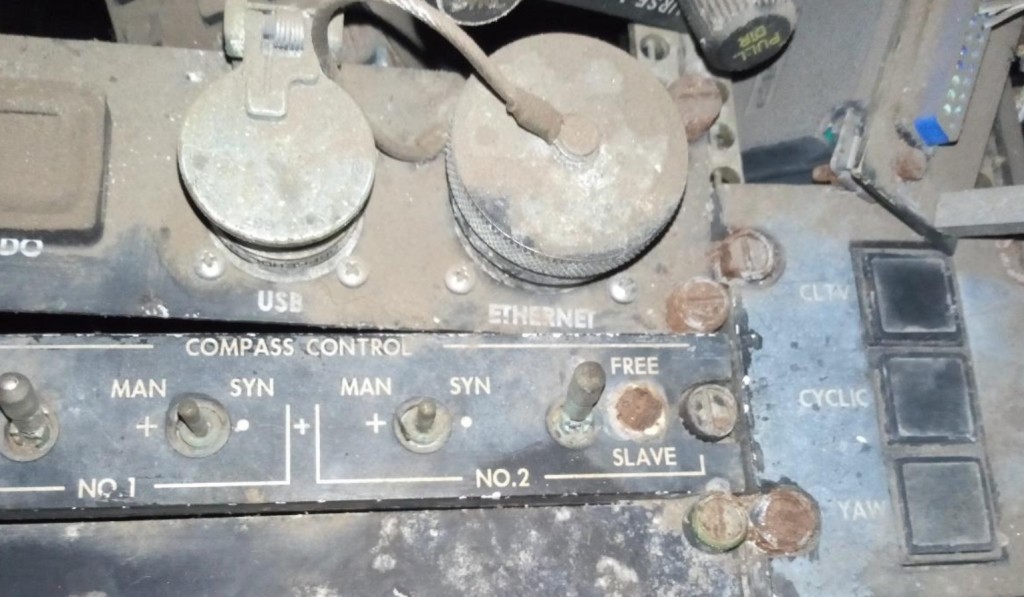Ditching of Bristow S-76C++, Off Nigeria, 3 February 2016
On 3 February 2016, Bristow Helicopters Nigeria Sikorsky S-76C++ 5N-BQJ ditched while en route from the deepwater ExxonMobil Erha Floating Production Storage Offloading (FPSO) vessel to Murtala Muhammed Airport Lagos.
Accident Flight
The Accident Investigation Bureau Nigeria (AIB Nigeria) say, in their safety investigation report (issued 25 April 2019), that on the outbound flight the Captain was the Pilot Flying (PF) while the First Officer was Pilot Monitoring (PM):
A few minutes into the [outbound] flight, the Captain observed an unusual vibration of the aircraft and made a remark about this to the First Officer. About fifteen minutes later, the crew also reported that the Digital Auto Flight Control System (DAFCS) and TRIM FAIL lights illuminated twice and were reset. The No.1 autopilot decoupled on both occasions. Also…a passenger seated in the middle row reported perceiving a burning smell.
The aircraft (MSN 760656 not 76056 as stated early in the AIB report) continued to its destination. On the Erha helideck the Captain “conducted visual checks but could not ascertain the source of the burning smell”.
At 09:50 h, 5N-BQJ departed Erha FPSO for Lagos on the second leg of the flight with nine passengers and two crew on board, the First Officer was the PF; estimating LAG 10:40 h and endurance of one hour plus thirty-five minutes maintaining an altitude of 3,000 ft above mean sea level (AMSL).
Fifteen minutes into the flight, there were repeated illuminations of ‘TRIM FAIL’ and Digital Automatic Flight Control System (DAFCS) indications. The Emergency Operating Procedure (EOP) was consulted and it recommended that the helicopter be flown hands and feet on the control.
At 10:08 h, about 75 NM from LAG, initial contact was made with Lagos Approach. The Pilot Flying (PF) complained of the collective being heavy and the autopilot decoupling. There was loss of power, high rate of descent and decreasing altitude. The Captain observed a slight turn to the right and asked the PF to check heading and the PF reported that there was problem with the compass.
The instrument readings were inaccurate and inconsistent, and the aircraft started drifting to the right.
At about 66 NM on radial 145º from LAG, the Captain made a distress call “MAY DAY, MAY DAY, MAY DAY” on the Approach frequency. Afterwards, the aircraft stabilized at an altitude of 1,500 ft AMSL on a NE-E heading and the Captain briefed the passengers that they would have to ditch the aircraft.
At about 10:19 h, 5N-BQJ made a controlled landing on water at approximately 77 NM on radial 139º of ‘LAG VOR’.
The Emergency Flotation System (EFS) deployed. The Co Pilot stated:
The [external] life-raft on the left was not fully deployed. This led to most passengers and crew utilizing the life raft on the right side.
All 11 POB exited the aircraft without any injury. They were picked up by the Sea Trucks Group craneship Jascon 25. The aircraft subsequently over turned.
Analysis
The AIB note that:
This aircraft was equipped with a dual DFZ-760 DAFCS systems that combines autopilot and flight director functions and requires synchronized heading input from the compass control among other inputs.
With the compass control panel SLAVE-FREE switches set to SLAVE, the gyro is slaved to the earth’s magnetic field to provide accurate heading information to the pilot’s and co-pilot’s EHSI [Electronic Horizontal Situation Indicators].
Where inputs from the compass control are not synchronized, a flight director malfunction may occur as was the case in this accident…[and]…as a result, the heading information being fed into the Flight Director were not synchronised, hence the crew were getting unreliable heading information.
The company Operations Manual (Part B) checklist requires that the compasses be selected to SLAVE mode after take-off.
During the flight from Erha to Lagos, the CVR transcript confirmed that the crew executed the items in the Bristow S76C++ Pre-Taxi, Before Take-off and After Take-off checklists, but omitted the crucial6 th item on the After Take-off/GoAround Checklist-Compasses…Check/Slaved
[Physical] evidence available to the Bureau indicated that the No. 1 & 2 COMPASSES were in FREE DG mode.
According to the CVR transcript, the First Officer said “Setting…., Setting…. Setting. Set the Compass. OK because the Compass seems to be turning by itself.” The Captain responded, “Turn to your Side. The Compass is Confusing.” The First Officer also remarked “yeah, what is going on, because I’m turning.” The Captain said, “Are you turning…I have control…”
The comments of the Captain and the First Officer indicated that they were alarmed.
AIB strangely make no comment that an S-76C+ (5N-BGD) had been lost in a fatal accident only 6 months before and the crew may well have had a heightened sensitivity to anomalous aircraft behaviour. AIB go on:
The crew should have confirmed the position of the Compass control switch and returned same to the SLAVE mode and the heading synchronized appropriately. This should have resolved the Flight Director malfunction and the flight would have continued normally.
Of course its easy for investigators to say what people should have done with the luxury of being cognisant of the full situation.
The First Officer told the Captain that the Altitude Holding was “Fine but the Heading is not accurate”. The First Officer went further to say “Yeah, the problem is that we don’t know the Heading in which we are right now. Which direction?” The aircraft deviated from the intended flight path.
Due to either an uncommanded control input by a degraded auto pilot or an inadvertent control input from PF, the aircraft went into a high rate of descent (2,100 ft/min)…loosing speed from 148 KIAS to 64 KIAS over the same period (60 seconds) before stabilizing at 1,500 ft
The crew became very agitated, but later regained control of the flight path at 1,000 ft AMSL. Thereafter, the crew stabilized the aircraft at 1,500 ft. According to the CVR transcript the Captain said, “we are maintaining 1,500 ft this time, we lost all our instruments.” The PF went further to say “Yeah, the problem is that we don’t know the heading in which we are right now. Which direction?” At this point the crew decided to ditch the aircraft.
Causal Factor
The crew switched the Compass to “FREE” DG mode for Landing on the helideck at Erha FPSO, and did not return to the “SLAVE” mode after take-off which caused the trim fail to cut off consistently which in turn disengaged the autopilot as a result of the unsynchronised heading inputs.
Contributory Factors
1) Non-adherence to Company Operations Manual (Part B checklist) as it relates to after take-off checks.
2)The crew did not disengage the autopilot to fly the aircraft manually.
Safety Recommendations
Four safety recommendations were made. Two related to FDR annual maintenance (only four parameters [Pressure Altitude, Indicated Airspeed, Master Caution and Autopilot Engaged 1 & 2] were downloaded successfully). One was to consider reviewing a procedure and the fourth was that the company “should ensure that Flight Crew follow approved checklist items, and procedures at all times”.
Safety Resources
- Hong Kong Harbour AW139 Ditching – HKCAD Report Issued
- ADA AW139 A6-AWN Ditching off UAE, 29 April 2017: Final Report
- Dramatic Malaysian S-76C 2013 Ditching Video
- In-Flight Flying Control Failure: Indonesian Sikorsky S-76C+ PK-FUP
- NTSB Report on 2013 S-76A++ Tail Rotor Blade Loss
- NTSB Report on Bizarre 2012 US S-76B Ditching
- BFU Investigate S-76B Descending to 20ft at 40 kts En Route in Poor Visibility
- Offshore Helicopter Accident Ghana 8 May 2014 & The Importance of Emergency Response
- CAP1145 Helicopter Water Impact Survivability Statistics – A Critique
- Helicopter Ditching – EASA Rule Making Team RMT.0120 Update
- Helicopter Ditching Limitations
- UPDATE 12 December 2020: NH90 Caribbean Loss of Control – Inflight, Water Impact and Survivability Issues
- UPDATE 9 January 2021: Korean Kamov Ka-32T Fire-Fighting Water Impact and Underwater Egress Fatal Accident
On error management:
…and our review of The Field Guide to Understanding Human Error by Sidney Dekker presented to the Royal Aeronautical Society (RAeS): The Field Guide to Understanding Human Error – A Review






Recent Comments